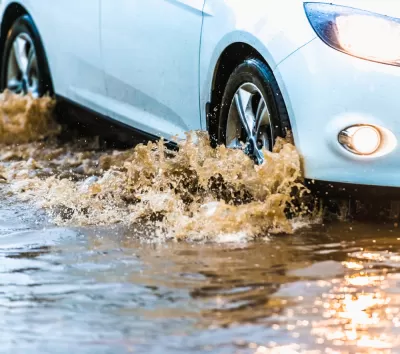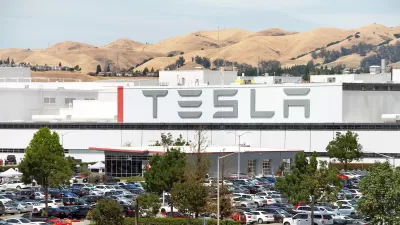Tires wear down and shed toxic microplastics into stormwater, which eventually ends up in rivers and the ocean. Recent research sheds new light on the extent of the damage.

Laura Trethewey shares details of ongoing research into the pollution created by the tires of cars—toxic waste that ends up in rivers and oceans and must be considered alongside particulate pollution and climate change emissions from the tailpipes of cars.
Trethewey is detailing research by a team at the San Francisco Estuary Institute (SFEI), recently testing water at 12 stormwater outlets around the Bay Area for three years, finding an estimated 7.2 trillion synthetic particles washing into San Francisco Bay each year.
In California, where most commuters cling to their cars, conversations about the environmental impact of automobiles usually involve what spews from tailpipes. Electric vehicles are sold as the solution for car emissions. But SFEI’s work has expanded the debate about the environmental impacts of cars to include tires shedding particles near the sea.
It's hard to change the nature of tires. They shed by design and engineering, according to the article, and recent changes in the science of tires has created a difficult-to-recycle product that also has consequences for landfills.
Other researchers around the world are studying the impact of tires on water quality, but an idea of the global scope of the problem is still being developed, but researchers have found a lot of bad news already, according to Trethewey.
In 2017, the International Union for Conservation of Nature estimated that 28.3 percent of microplastics in the ocean come from tires, landing them in the top seven contributors. But the real number is likely higher. A study published in July suggests that vast quantities of tire fragments find their way into the ocean not just via rivers and waterways, but also through the air. Swept on the wind, they drift far from where they are shed. The study warned that so many tire particles are landing in the Arctic that they pose a climate change risk. By turning the snowy tundra a less reflective white, the polluted Arctic ice may absorb more light and melt even faster.
The fresh news about the environmental impacts of tires led to quite a bit of discussion on social media in recent days, as anti-car advocates used the news to throw a bit of cold water on the idea of electric cars as a panacea for the negative externalities of automobiles. Others pushed back, saying electric cars are an essential step in the right direction in the fight to prevent the worst effects of climate change.
FULL STORY: When Rubber Hits the Road—and Washes Away

Manufactured Crisis: Losing the Nation’s Largest Source of Unsubsidized Affordable Housing
Manufactured housing communities have long been an affordable housing option for millions of people living in the U.S., but that affordability is disappearing rapidly. How did we get here?

Americans May Be Stuck — But Why?
Americans are moving a lot less than they once did, and that is a problem. While Yoni Applebaum, in his highly-publicized article Stuck, gets the reasons badly wrong, it's still important to ask: why are we moving so much less than before?

Using Old Oil and Gas Wells for Green Energy Storage
Penn State researchers have found that repurposing abandoned oil and gas wells for geothermal-assisted compressed-air energy storage can boost efficiency, reduce environmental risks, and support clean energy and job transitions.

Updating LA’s Tree Rules Could Bring More Shade to Underserved Neighborhoods
A new USC study finds that relaxing Los Angeles’ outdated tree planting guidelines could significantly expand urban tree canopy and reduce shade disparities in lower-income neighborhoods, though infrastructure investments are also needed.

California's Canal Solar Projects Aim to Conserve Resources and Expand Clean Energy
California’s Project Nexus has begun generating electricity from solar panels installed over irrigation canals, with researchers and state agencies exploring statewide expansion to conserve water and boost clean energy production.

HHS Staff Cuts Gut Energy Assistance Program
The full staff of a federal program that distributes heating and cooling assistance for low-income families was laid off, jeopardizing the program’s operations.
Urban Design for Planners 1: Software Tools
This six-course series explores essential urban design concepts using open source software and equips planners with the tools they need to participate fully in the urban design process.
Planning for Universal Design
Learn the tools for implementing Universal Design in planning regulations.
Heyer Gruel & Associates PA
City of Moreno Valley
Institute for Housing and Urban Development Studies (IHS)
City of Grandview
Harvard GSD Executive Education
Salt Lake City
NYU Wagner Graduate School of Public Service
City of Cambridge, Maryland





























